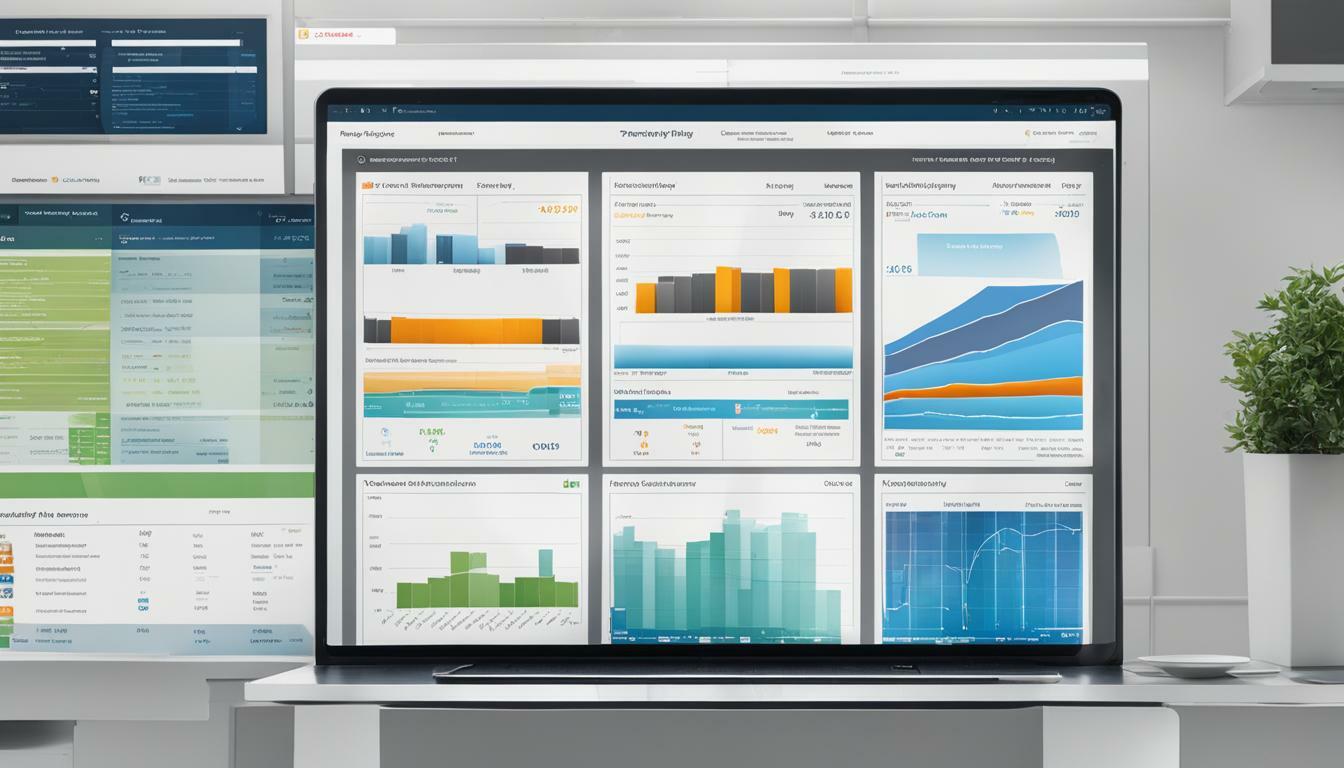HVAC project management software integrations are crucial for optimizing your business operations and streamlining project workflows. With the right integrations, you can connect your project management software with other tools and systems, enabling seamless data transfer, improved communication, and increased productivity.
Integrating your HVAC project management software with other tools and systems offers a range of benefits. By bringing together different software solutions, you can enhance collaboration among team members, access real-time data insights, and streamline your business processes. Whether you need to integrate with accounting software, CRM systems, estimation tools, or inventory management systems, there are options available to suit your specific needs.
Key Takeaways:
- Integrating HVAC project management software with other tools and systems optimizes business operations and streamlines project workflows.
- Benefits of integration include improved collaboration, real-time data insights, and streamlined business processes.
- Popular integrations for HVAC project management software include accounting software, CRM systems, estimation tools, and inventory management systems.
- Accounting software integrations enhance financial tracking and invoicing processes.
- CRM system integrations improve customer relationships and enable comprehensive customer data management.
Understanding the Benefits of PM Software Integrations
By integrating your HVAC project management software with other tools and systems, you can unlock a range of benefits that will propel your business forward. These integrations enhance productivity, improve collaboration, and provide real-time data insights, allowing you to streamline your operations and make informed decisions.
One of the key benefits of PM software integrations is increased efficiency. When your project management software seamlessly integrates with other tools such as accounting software, CRM systems, estimation tools, and inventory management systems, you eliminate the need for manual data entry and reduce the risk of errors. This automated data transfer saves time and effort, allowing you to focus on more critical tasks.
Collaboration is another area that significantly improves with integrations. When all your systems are connected, team members can easily share information, access project updates in real-time, and communicate effectively. This improved collaboration fosters better teamwork, reduces miscommunication, and ensures everyone is on the same page, leading to smoother project execution.
Furthermore, PM software integrations provide valuable data insights that can guide your decision-making process. With integrated systems, you have access to comprehensive and up-to-date information, enabling you to analyze project performance, track financials, monitor inventory levels, and evaluate customer relationships. These insights empower you to identify trends, make data-driven decisions, and optimize your business strategies.

| Benefits of PM Software Integrations |
|---|
| Increased efficiency through automated data transfer |
| Improved collaboration and communication |
| Access to valuable data insights for informed decision-making |
Popular Integrations for HVAC Project Management Software
There are various integration options available for HVAC project management software, allowing you to connect and streamline multiple aspects of your business operations. By integrating your project management software with other tools and systems, you can enhance productivity, improve collaboration, and gain real-time insights into your projects.
One popular integration for HVAC project management software is with accounting software. This integration allows you to seamlessly transfer data between the two systems, improving financial tracking and streamlining invoicing and billing processes.
Another common integration is with CRM systems. By integrating your project management software with a CRM system, you can enhance customer relationships, improve communication, and effectively manage customer data.
Estimation tools are also commonly integrated with HVAC project management software. This integration can streamline the bidding process, improve accuracy in estimating costs, and enhance project planning.
| Integration | Benefits |
|---|---|
| Accounting Software | Seamless data transfer, improved financial tracking, streamlined invoicing and billing |
| CRM Systems | Enhanced customer relationships, improved communication, comprehensive customer data management |
| Estimation Tools | Streamlined bidding process, improved accuracy in estimating costs, enhanced project planning |
These are just a few examples of the integrations available for HVAC project management software. There are also integrations with inventory management systems, scheduling and dispatching tools, field service management software, quality control systems, and business intelligence and analytics tools. By choosing the right integrations for your business, you can optimize your workflows and improve efficiency.

Overall, integrating your HVAC project management software with other tools and systems is essential for maximizing productivity and efficiency in the HVAC industry. Consider your specific needs and requirements when selecting integrations and explore the available options to optimize your business processes.
Accounting Software Integrations for HVAC Project Management Software
Integrating your HVAC project management software with accounting software provides a seamless flow of financial data and streamlines your invoicing and billing processes. This integration allows for real-time synchronization of information, eliminating the need for manual data entry and reducing the risk of errors. By automating financial tasks, you can save time and improve the accuracy of your financial records.
With the integration of accounting software, you can easily generate and send invoices directly from your project management software. The software can automatically pull data from your projects, such as billable hours, materials used, and expenses incurred, to create accurate and detailed invoices. This ensures that you are billing your clients correctly and promptly, improving cash flow for your business.
Furthermore, integrating accounting software with your HVAC project management system allows for better financial tracking and reporting. You can monitor your project costs in real-time, track expenses, and analyze profitability. This data can help you make informed decisions about resource allocation, project pricing, and overall business strategy.
Example of Integrating HVAC Project Management Software with Accounting Software
| Benefits | Accounting Software | HVAC Project Management Software |
|---|---|---|
| Seamless flow of financial data | X | X |
| Automated invoicing and billing | X | X |
| Real-time financial tracking and reporting | X | X |
| Improved cash flow | X | |
| Accurate project costing and profitability analysis | X |
By integrating accounting software with your HVAC project management software, you can streamline your financial processes and gain valuable insights into your business’s financial health. It is important to choose a project management software that offers seamless integration with popular accounting software solutions, such as QuickBooks or Xero. This will ensure compatibility and a smooth transition of data between the two systems.
Overall, accounting software integrations for HVAC project management software can help you save time, improve accuracy, and make more informed financial decisions. By automating financial tasks and gaining real-time visibility into your finances, you can focus on growing your business and delivering exceptional service to your clients.

CRM System Integrations for HVAC Project Management Software
Integrating your HVAC project management software with a CRM system empowers you to better manage customer relationships and enhance communication channels. With a seamless integration, you can consolidate customer data, track interactions, and streamline your sales and marketing processes. By centralizing customer information, you can gain deeper insights into your clients’ needs and preferences, allowing you to tailor your services and offerings more effectively.
One of the key benefits of CRM system integration is improved communication. By synchronizing your project management software with your CRM, you can ensure that all customer communications, from initial inquiries to project updates and post-service follow-ups, are recorded and easily accessible. This helps to maintain consistent and personalized interactions, regardless of the team member handling the customer request.
Additionally, CRM integrations enable you to automate workflows and streamline your customer service processes. By leveraging automation, you can send automated reminders, notifications, and updates to your clients, improving customer satisfaction and reducing the risk of missed deadlines or miscommunications.
Example Table:
| Benefits of CRM System Integration for HVAC Project Management Software | Enhanced customer relationship management | Improved communication channels | Streamlined sales and marketing processes |
|---|---|---|---|
| Centralized customer data | ✔️ | ||
| Automated workflows | ✔️ | ||
| Personalized interactions | ✔️ |
By integrating your HVAC project management software with a CRM system, you can streamline your operations, enhance customer satisfaction, and drive business growth. Remember to consider factors like ease of integration, compatibility with your existing systems, and the availability of customer support when selecting the right CRM system to integrate with your project management software. With the right integration, you can take your HVAC business to new heights.

Estimation Tools Integrations for HVAC Project Management Software
Integrating your HVAC project management software with estimation tools streamlines your bidding process, improves cost estimating accuracy, and enhances project planning capabilities. By incorporating estimation tools into your project management software, you can save time and effort by automating the process of creating accurate and detailed project estimates. This integration allows you to generate comprehensive cost projections, including materials, labor, and other expenses, with just a few clicks.
Estimation tools integration also ensures that your project management software remains up-to-date with the latest pricing information from your suppliers. With real-time pricing data, you can avoid costly estimation errors and provide your clients with accurate quotes for their HVAC projects. Furthermore, integrated estimation tools enable you to analyze and compare multiple project scenarios, allowing you to make informed decisions and optimize your bidding strategy.
To illustrate the benefits of estimation tools integration even further, consider the following example: Suppose you need to estimate the cost of an HVAC installation project. By using integrated estimation tools, you can quickly input project parameters, such as square footage, equipment requirements, and complexity level. The estimation tool will then generate an itemized cost breakdown, labor requirements, and project timelines, providing you with a comprehensive and accurate estimate. This integration eliminates the need for manual calculations and minimizes the risk of errors, saving you valuable time and resources.
Benefits of Estimation Tools Integrations:
- Streamline the bidding process: Integrated estimation tools automate the creation of accurate and detailed project estimates, saving time and effort for contractors.
- Improve cost estimating accuracy: Real-time pricing data ensures that estimates reflect the most up-to-date information, reducing the risk of costly estimation errors.
- Enhance project planning capabilities: Detailed cost breakdowns and project timelines enable contractors to make informed decisions and optimize their bidding strategy.

| Estimation Tool | Key Features |
|---|---|
| Tool 1 | Automated cost estimation, customizable templates, integration with supplier databases |
| Tool 2 | Real-time pricing updates, comparative analysis, project scenario planning |
| Tool 3 | Material takeoff, labor allocation, resource scheduling |
By integrating your HVAC project management software with estimation tools, you can streamline your bidding process, improve cost estimating accuracy, and enhance project planning capabilities. Take advantage of the automation and real-time data provided by these integrated tools to stay ahead of the competition and deliver successful HVAC projects.
Inventory Management System Integrations for HVAC Project Management Software
Integrating your HVAC project management software with an inventory management system enables real-time tracking of inventory, automates purchase orders, and optimizes material management. This integration allows you to efficiently manage your HVAC projects by ensuring that you have the right materials at the right time, avoiding delays and reducing costs.
With real-time inventory tracking, you can easily monitor the availability and usage of materials for each project. This helps you identify any shortages or excesses in your inventory, allowing you to make informed decisions regarding material procurement and allocation. By automating purchase orders, you can streamline the ordering process, ensuring that you never run out of essential materials. This saves you time and effort by eliminating manual order creation and minimizes the risk of errors or missed orders.
Optimizing material management is another key benefit of integrating your HVAC project management software with an inventory management system. The integration provides you with comprehensive visibility into your inventory, helping you make informed decisions about material usage, storage, and replenishment. It enables you to track material costs, consumption rates, and waste, allowing you to identify areas for improvement and cost-saving opportunities. By efficiently managing your materials, you can minimize waste, reduce inventory holding costs, and improve overall project profitability.
By harnessing the power of integration between HVAC project management software and an inventory management system, you can enhance your project efficiency and profitability. Real-time tracking, automated purchase orders, and optimized material management will not only save you time and money but also improve your overall project execution. Take advantage of this integration to ensure smooth project operations and deliver high-quality results to your clients.
Inventory Management System Integration Example
| Benefits | Explanation |
|---|---|
| Real-time inventory tracking | Monitor the availability and usage of materials for each project. |
| Automated purchase orders | Streamline the ordering process and avoid material shortages. |
| Optimized material management | Make informed decisions about material usage, storage, and replenishment. |

Other Integrations and Considerations for HVAC Project Management Software
Beyond the core integrations, there are several other tools and systems you can integrate with your HVAC project management software to further enhance your operational efficiency and decision-making capabilities. These additional integrations can provide valuable insights and streamline various aspects of your business processes.
One important integration to consider is with scheduling and dispatching tools. By connecting your HVAC project management software with a scheduling and dispatching system, you can optimize your workforce allocation, track job progress in real-time, and ensure timely completion of projects. This integration enables efficient resource management and minimizes delays, enhancing overall project efficiency and customer satisfaction.
Another valuable integration for HVAC project management software is with field service management software. This integration allows for seamless coordination between your field technicians and the office, enabling efficient communication, task allocation, and job tracking. With this integration, you can optimize your field operations, improve response times, and enhance customer service.
Example Table
| Integration | Benefits |
|---|---|
| Inventory Management System | Real-time inventory tracking, automated purchase orders, enhanced material management |
| Quality Control System | Streamlined quality assurance processes, improved compliance, enhanced customer satisfaction |
| Business Intelligence and Analytics | Data-driven insights, performance tracking, informed decision-making |
In addition, integrating your HVAC project management software with a quality control system can help ensure that your projects meet industry standards and customer expectations. This integration enables streamlined quality assurance processes, improved compliance with regulations, and enhanced customer satisfaction.
To gain deeper insights into your business performance and make informed decisions, consider integrating your project management software with a business intelligence and analytics tool. This integration allows you to analyze data, track project performance, identify trends, and optimize your business processes based on data-driven insights.
By exploring these integrations and considering the specific needs of your HVAC business, you can leverage your project management software to its fullest potential, enhancing efficiency, collaboration, and ultimately, your bottom line.

Conclusion
Integrating your HVAC project management software with other tools and systems is essential for maximizing productivity and efficiency in your business operations. By seamlessly connecting your project management software with accounting software, CRM systems, estimation tools, inventory management systems, and more, you can enhance collaboration, streamline processes, and gain valuable insights.
One of the key benefits of integrating project management software is improved productivity. With integrations, you can eliminate manual data entry and streamline workflows, allowing your team to focus on delivering quality projects. Real-time data synchronization ensures that everyone is working with the most up-to-date information, reducing errors and delays.
Collaboration is also greatly enhanced through integrations. By connecting your project management software with CRM systems, you can track customer interactions, manage leads and opportunities, and deliver personalized experiences. Integration with estimation tools enables accurate and efficient cost estimation, helping you win more bids and plan projects effectively.
Furthermore, integrating HVAC project management software with accounting software enables seamless financial tracking and billing processes. You can easily generate invoices, track expenses, and keep a close eye on your project’s financial health. Integrating with inventory management systems ensures real-time inventory tracking, automates purchase orders, and optimizes material management.
As you explore the available integration options, consider your specific needs and priorities. Look for software that offers ease of use, scalability, and reliable customer support. Evaluate the functionality and compatibility of the integrations to ensure a seamless experience. By selecting the right integrations, you can unlock the full potential of your project management software and take your HVAC business to new heights of success.
FAQ
What is HVAC project management software?
HVAC project management software is a tool that helps HVAC companies manage their projects more efficiently and effectively. It offers features like job scheduling and tracking, inventory management, customer relationship management, reporting and analytics, and access to training materials.
What are the benefits of using HVAC project management software?
By utilizing HVAC project management software, contractors can increase efficiency, improve communication and collaboration, enhance customer relationships, and improve financial management.
What are the drawbacks of HVAC project management software?
Some drawbacks to consider include the high cost and the learning curve associated with using the software.
What types of HVAC project management software are available?
HVAC project management software includes estimating and bidding software, scheduling and dispatching software, field service management software, quality control software, and business intelligence and analytics software.
What are the options for deploying HVAC project management software?
Contractors have the option to choose between on-premise or cloud-based (SaaS) software, each with its own advantages and considerations.
What factors should contractors consider when selecting HVAC project management software?
Contractors should determine their specific needs and consider factors like ease of use, functionality, scalability, integration, customer support, and cost.





0 Comments